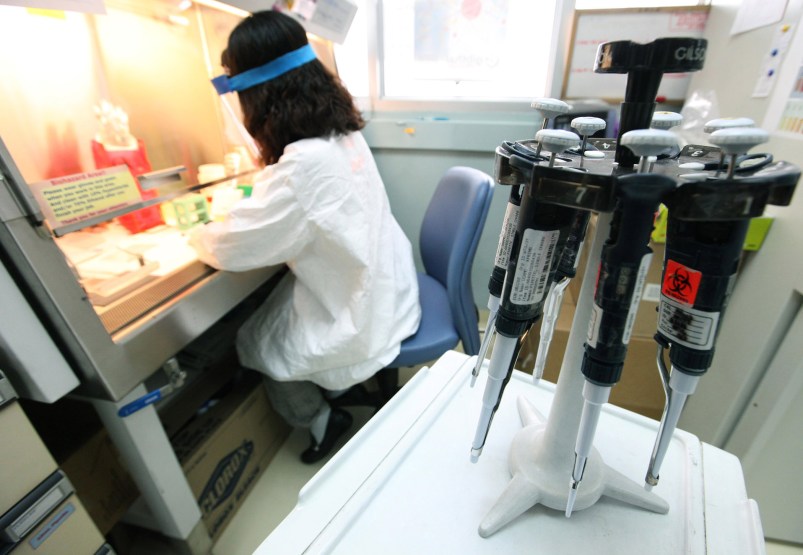In 1987, a person diagnosed with HIV/AIDS was given six months to live. In 2014, medical and biopharmaceutical breakthroughs offer patients with the same diagnosis a markedly different prognosis: the chance to lead a normal life.
And now, nearly 35 years after the Centers for Disease Control and Prevention (CDC) recognized the AIDS virus, a vaccine may finally be on the horizon.
Dr. Raymond Schinazi, a world leader in nucleoside chemistry and a pioneer in the treatment of HIV/AIDS, was on Capitol Hill on Wednesday, September 10th, to talk about recent innovations in treatment. At the briefing, Schinazi told congressional aides, government non-profit employees, drug company representatives and patient advocates that, with all the resources in place, a vaccine could come in “seven to eight years.”
“We’re not too far. We have the knowledge and technology,” he said. “It’s a possibility, if we have the willpower to do it.”
Schinazi, who received the 2014 PhRMA Research & Hope Award for Excellence in Academic Research last week, spoke at length about the extraordinary number of advances in treatment in the last three decades.

There are currently 44 new medicines, therapies and vaccines in development to help treat HIV/AIDS – all aimed at more effectively treating those with the disease and preventing others from ever contracting it. Among the vaccines and therapies in development are attachment inhibitors intended to prevent the virus from attaching to new cells, gene modification therapy that could make a patient’s cells resistant to HIV infection, and a vaccine that could target immune response and T-cell exhaustion.
In short: 44 steps toward greater progress.
The rate of medical discovery around the virus has been overwhelming. Since 1981, there have been over 40 approved medicines to treat HIV/AIDS. New infections have dropped 38 percent since 2001, according to UNAIDS. In the U.S., the HIV/AIDS death rate has fallen by over 80 percent since the introduction of antiretroviral therapies in 1995.
George Hanna, M.D., Vice President of HIV Development at Bristol-Myers Squibb and the winner of PhRMA’s 2014 Research & Hope Award for Excellence in Biomedical Research, spoke passionately about the importance of interlocking systems of treatment, advocacy, care and funding if a cure is to be found and HIV/AIDS is to be eradicated on a local and global scale.
“Less than half of the people in the U.S. have adequate control of their HIV,” he told the Capitol Hill audience. “We need to get people to know their status and to get care so they can extend their lives.”
Each of the four award winners on the panel spoke about how combining effective therapies with advocacy and human services is key to tackling the 50,000 new infections reported every year. After all, there are about 1.1 million HIV/AIDS sufferers living in the U.S. today, 15.8 percent of whom are unaware that they are infected.
Multi-level support and collaboration is essential for success, said William Chin, MD, Executive Vice President, Science and Regulatory Affairs for PhRMA. Drug companies and researchers are helped by patient advocates, heathcare non-profits, government organizations, academic institutions and educators.
“Medicines alone are not sufficient to end the fight,” said Chin.

Phill Wilson, President and CEO of the Black AIDS Institute and winner of the Research & Hope Award for Excellence in Advocacy and Activism, credited activism and patient advocacy as the unsung heroes in the fight against HIV/AIDS.
“HIV advocacy is the most powerful movement in the history of medicine,” he said. “We’ve been there every step of the way, streamlining the drug approval process, helping to improve doctor-patient relationships, talking to Congress. The quantum leaps from 1982 to today are due to patient advocacy force.”
Wilson likened the HIV/AIDS battle to a marathon.
“We’re at mile 18,” he said. “We’ve come so far but that’s where you hit the wall. We still have many challenges to push through if we’re going to make it to the finish line.”
Hydeia Broadbent, winner of the Research & Hope Award for Excellence in Visibility and Progress, was diagnosed with HIV/AIDS when she was three. Broadbent, now 30, has spent her life promoting testing initiatives, safe sex education, support against stigma and promoting awareness to young people.
She spoke candidly about surviving overwhelming odds thanks in part to breakthrough treatments and medical advances. She said that along with a cure, it’s more important than ever to connect with young people and to encourage them to get tested and seek treatment.

(Photo Courtesy of PhRMA)
“Someone has to tell the young people to take their meds and that its worth it to fight. I work to encourage others to get tested,” she said. “There are young people that think that HIV/AIDS is no longer a problem.”
Kathie Hiers, CEO of AIDS Alabama and a member of the the Planning Committee for the White House Summit on HIV and the South and winner of the Research & Hope Award for Excellence in HIV/AIDS Community Champion Award, talked about the impact of HIV/AIDS from a regional perspective.
“We’ve got the highest death rate in the country,” she said of her home state.
She then closed the discussion by highlighting the struggles patients face when it comes to housing, transportation and affordability of services and treatments – and where she sees future progress taking place. “To end the HIV/AIDS epidemic,” she said, “we’ve got to go through the South.”
Sources:
William Chin, Research & Hope Educational Forum, introductory remarks. (Sept. 10, 2014)
Medicines in Development HIV/AIDS, 2014 report
CDC, cited by Medicines in Development HIV/AIDS, 2014 report
William Chin, Research & Hope Educational Forum, introductory remarks. (Sept. 10, 2014)
Hydeia Broadbent, & Hope Educational Forum, panel discussion (Sept. 10, 2014)
Kathie Hiers, Research & Hope Educational Forum, panel discussion (Sept. 10, 2014)






